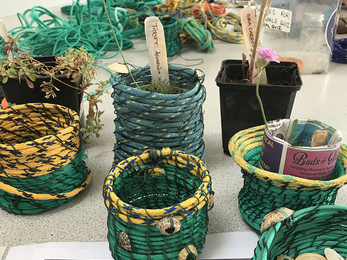Working at DWT’s Fine Foundation Wild Seas Centre in Kimmeridge I have developed a great admiration for the plants that manage to survive in the harshest of conditions by the sea. Some thrive along the cliffs where they face the full force of strong, salt-laden winds while others actually grow in the sand on beaches with the constant threat of inundation by waves. Most plants would not survive here, so the ones that do have evolved very special adaptations to avoid drying out and to cope with the lack of fresh water and nutrients. Adaptations include having small, fleshy or hairy leaves to retain precious water and spreading adventitious roots to seek out pockets of nutrients buried in the sand.
The plants that live along our stunning coastline, such as yellow-horned poppy, sea rocket and sea campion, are beautiful and often appear delicate and inadequate for the task of withstanding regular gales and storms. However they offer a vital food-source for pollinators that are endemic to the coast and which would not survive without them.
Our small coastal garden at the Wild Seas Centre is at its best in May through to July, when most of the plants are in full flower and put on a truly colourful and vibrant show. At this time of year it is literally buzzing with bees, hoverflies, butterflies and other pollinators. This year, for the Get Dorset Buzzing campaign, we have been offering plants grown from our own seed to visitors with coastal-themed gardens.
Tackling the problem of marine litter is a major focus for us at the Wild Seas Centre and we have come across a way that we can tackle one of the most harmful types of litter whilst promoting the importance of coastal plants. These plants look great in hand-crafted pots made from ghost fishing net picked up during beach cleans. In fact in July we ran a demonstration on how to make pots from this most deadly of marine litter. They make a colourful addition to coastal gardens and at the same time repurpose beach litter, encouraging people to collect this type of waste when out on the beach, preventing it from entangling unsuspecting wildlife. This craft is rather addictive and my garden now has several, variously coloured plant pots made of fishing litter.
This autumn and winter you will find me combing Dorset’s beaches for stranded ghost fishing line, getting it out of the environment, ready for making more planters during those long, dark winter evenings.
Find out more about the Fine Foundation Wild Seas Centre


